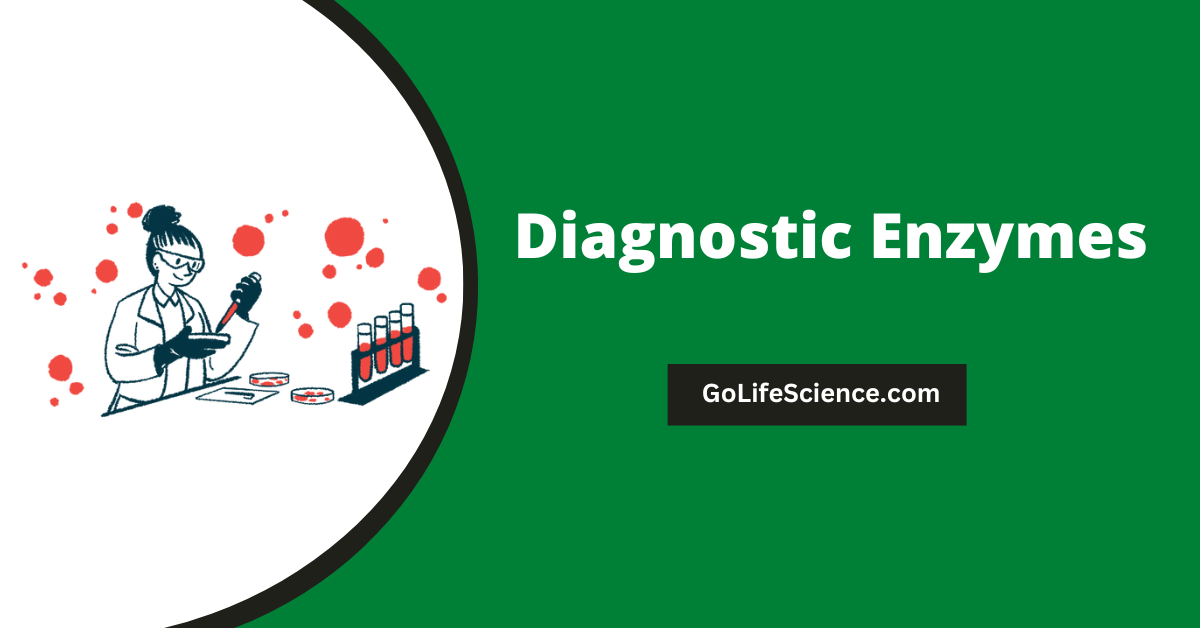
Diagnostic enzymes play a pivotal role in the detection, diagnosis, and monitoring of various diseases. These biological catalysts, which accelerate chemical reactions in the body, have become indispensable tools in clinical laboratories. From liver function tests to cardiac markers, diagnostic enzymes provide critical insights into the health status of patients.
Enzymes as biocatalysts have been widely used in industrial processes such as food processing, beer fermentation, laundry detergents, pickling purposes, and control, as well as accelerating the catalytic reactions in order to quickly and precisely obtain various valuable end products.

The enzymes are more frequently used in both laboratories and commercially for the purpose of stereospecific bioconversion, utilization of waste into useful end products for a better environment, for the production of raw materials, and many more.
This article delves into the world of diagnostic enzymes, exploring their types, functions, applications, and the latest advancements in the field.
Table of Contents
What are the Diagnostic enzymes?
Enzymes are proteins that act as catalysts in biochemical reactions, speeding up the rate at which these reactions occur without being consumed in the process. Diagnostic enzymes are specific enzymes whose levels or activities are measured in clinical settings to diagnose or monitor diseases. These enzymes are often released into the bloodstream in response to tissue damage or disease, making them valuable biomarkers.
Importance in Clinical Diagnostics
Diagnostic enzymes are crucial for several reasons:
- Early Detection: They can indicate the presence of a disease before clinical symptoms manifest.
- Disease Monitoring: They help in tracking the progression or regression of a disease.
- Therapeutic Guidance: They assist in determining the effectiveness of a treatment.
- Prognostic Value: They provide information on the likely course and outcome of a disease.
Types of Diagnostic Enzymes: A Comprehensive Overview
Diagnostic enzymes are specialized proteins that play a critical role in diagnosing and monitoring various diseases. These enzymes are often released into the bloodstream in response to tissue damage, inflammation, or disease, making them valuable biomarkers for clinical diagnostics. Below, we delve deeper into the different types of diagnostic enzymes, their specific functions, and their clinical significance.
1. Liver Enzymes
The liver is the largest internal organ and plays an important role in many functions of the body, including blood detoxification, cholesterol, glucose, iron metabolism, etc. Various conditions affect the normal functioning of the liver, including hepatitis, Epstein Barr virus infection, fatty liver.
Liver enzymes are among the most commonly measured diagnostic enzymes in clinical practice. They are crucial for assessing liver health and diagnosing conditions such as hepatitis, cirrhosis, and liver damage caused by toxins or medications.
In these anomalies, several enzymes are released into the blood, and quantification of these catalysts can lead to disease detection. The measurement of the serum levels of numerous enzymes has been shown to be of diagnostic significance as Diagnostic Enzymes. This is because the presence of these enzymes in the serum indicates that tissue or cellular damage has occurred resulting in the release of intracellular components into the blood.
Commonly assayed enzymes are the aminotransferases:
- Alanine Transaminase (ALT): sometimes still referred to as Serum Glutamate-Pyruvate aminoTransferase, SGPT) and
- Aspartate Aminotransferase (AST): It is also referred to as Serum Glutamate-Oxaloacetate aminoTransferase, SGOT);
- Lactate dehydrogenase (LDH)
- Creatine Kinase (CK): It is also called creatine phosphokinase, CPK);
- Gamma-Glutamyl Transpeptidase (GGT)
The primary liver enzymes include:
Alanine Aminotransferase (ALT)
- Function: ALT is primarily found in liver cells (hepatocytes) and is involved in the metabolism of amino acids.
- Clinical Significance: Elevated ALT levels are a strong indicator of liver damage, as this enzyme is released into the bloodstream when liver cells are injured. It is highly specific to the liver, making it a key marker for conditions like viral hepatitis, non-alcoholic fatty liver disease (NAFLD), and drug-induced liver injury.
- Normal Range: 7–56 U/L (units per liter).
Aspartate Aminotransferase (AST)
- Function: AST is found in the liver, heart, skeletal muscles, kidneys, and brain. It plays a role in amino acid metabolism.
- Clinical Significance: While AST is less specific to the liver than ALT, elevated levels can indicate liver damage, heart attack, or muscle injury. The AST/ALT ratio is often used to differentiate between liver diseases (e.g., alcoholic liver disease vs. viral hepatitis).
- Normal Range: 10–40 U/L.
AST and ALT
The typical liver enzymes measured are AST and ALT. ALT is particularly diagnostic of liver involvement as this enzyme is found predominantly in hepatocytes.
When assaying for both ALT and AST the ratio of the level of these two enzymes can also be diagnostic. Normally in liver disease or damage that is not of viral origin, the ratio of ALT/AST is less than 1.
However, with viral hepatitis, the ALT/AST ratio will be greater than 1. Measurement of AST is useful not only for liver involvement but also for heart disease or damage.
The level of AST elevation in the serum is directly proportional to the number of cells involved as well as on the time following an injury that the AST assay was performed. Following injury, levels of AST rise within 8 hours and peak 24–36 hours later.
Within 3–7 days the level of AST should return to pre-injury levels, provided a continuous insult is not present or further injury occurs. Although measurement of AST is not, in and of itself, diagnostic for myocardial infarction, taken together with LDH and CK measurements (see below) the level of AST is useful for timing of the infarct.
Alkaline Phosphatase (ALP)
- Function: ALP is present in the liver, bile ducts, bones, and placenta. It is involved in breaking down proteins and is essential for bone mineralization.
- Clinical Significance: Elevated ALP levels can indicate bile duct obstruction (e.g., gallstones or tumors), liver diseases, or bone disorders such as Paget’s disease or osteomalacia.
- Normal Range: 44–147 U/L.
Gamma-Glutamyl Transferase (GGT)
- Function: GGT is found in the liver, bile ducts, and pancreas. It plays a role in glutathione metabolism and the transport of amino acids.
- Clinical Significance: GGT is highly sensitive to bile duct issues and alcohol consumption. Elevated levels are often seen in chronic alcohol abuse, cholestasis, and liver diseases.
- Normal Range: 9–48 U/L.
Other enzymes are assayed under a variety of different clinical situations but they will not be covered here.
| Enzyme | Disorder / Disease |
|---|---|
| Acid Phosphatase | Malaria |
| Alanine aminotransferase | Hepatocellular damage and Hepatitis B and C |
| Alkaline phosphatase | Chronic kidney disease, Oseomalasis, Type II diabetes, Obstructed Liver |
| Amylase | Pancreatitis and Myocardial infraction |
| Aspartate aminotransferase | Hepatic diseases, Dental disorder, Liver fibrosis |
| Creatine kinase | Myocardial damage, Neuroleptic malignant syndrome |
| Gamma glutamyl transferase | Cardiovascular mortality, |
| Gelatinase-B | Gastric cancer, Vascular dementia, Rheumatoid arthritis, Malignant gliomas |
| Glucose-6-phosphatase | Gierke disease, Hypoglycemia |
| Lipase | Acute pancreatitis, Skin disorders |
| Lysozyme | Rheumatoid arthritis, Tuberculous meningitis, Tuberculous pericarditis |
| Lactate dehydrogenase | Pyroptosis, Necrosis, Breast cancer |
| Glucose-6-phosphate dehydrogenase | Gastric cancer |
Hence, when a physician indicates that he/she is going to assay for liver enzymes, the purpose is to ascertain the potential for liver cell damage.
2. Cardiac Enzymes
Cardiac enzymes are released into the bloodstream when the heart muscle is damaged, such as during a heart attack (myocardial infarction). These enzymes are critical for diagnosing and managing cardiovascular diseases.
Creatine Kinase (CK)
- Function: CK is found in the heart, brain, and skeletal muscles. It plays a key role in energy production by catalyzing the conversion of creatine to phosphocreatine.
- Clinical Significance: The CK-MB isoform is specific to the heart muscle. Elevated CK-MB levels indicate myocardial infarction or other heart muscle damage.
- Normal Range:
- Total CK: 22–198 U/L (men), 22–180 U/L (women).
- CK-MB: <5% of total CK.
Troponins (Troponin I and Troponin T)
- Function: Troponins are regulatory proteins found in cardiac and skeletal muscles. They control the calcium-dependent interaction between actin and myosin during muscle contraction.
- Clinical Significance: Troponin I and Troponin T are highly specific and sensitive markers for myocardial infarction. Elevated levels can be detected within 3–4 hours of heart muscle damage and remain elevated for up to 10 days.
- Normal Range:
- Troponin I: <0.04 ng/mL.
- Troponin T: <0.01 ng/mL.
Lactate Dehydrogenase (LDH)
- Function: LDH is found in almost all body tissues, including the heart, liver, kidneys, and muscles. It catalyzes the conversion of lactate to pyruvate during anaerobic metabolism.
- Clinical Significance: Elevated LDH levels can indicate heart attack, liver disease, hemolysis, or muscle injury. However, it is less specific than troponins or CK-MB.
- Normal Range: 140–280 U/L.
3. Pancreatic Enzymes
Pancreatic enzymes are essential for diagnosing disorders of the pancreas, such as pancreatitis or pancreatic cancer. These enzymes are released into the bloodstream when the pancreas is inflamed or damaged.
Amylase
- Function: Amylase is produced by the pancreas and salivary glands. It breaks down carbohydrates into simple sugars.
- Clinical Significance: Elevated amylase levels are a hallmark of acute pancreatitis. However, levels can also rise in salivary gland disorders, kidney disease, or intestinal perforation.
- Normal Range: 30–110 U/L.
Lipase
- Function: Lipase is produced by the pancreas and is responsible for breaking down fats into fatty acids and glycerol.
- Clinical Significance: Lipase is more specific to the pancreas than amylase. Elevated levels are primarily seen in acute pancreatitis, making it a more reliable marker for this condition.
- Normal Range: 10–140 U/L.
4. Muscle Enzymes
Muscle enzymes are released into the bloodstream when muscle tissue is damaged due to injury, inflammation, or disease. These enzymes are critical for diagnosing muscle disorders.
Creatine Kinase (CK)
- Function: As mentioned earlier, CK is involved in energy production in muscles.
- Clinical Significance: Elevated CK levels are seen in muscle disorders such as muscular dystrophy, myositis, and rhabdomyolysis (a condition caused by severe muscle breakdown).
- Normal Range:
- Total CK: 22–198 U/L (men), 22–180 U/L (women).
Lactate Dehydrogenase (LDH)
- Function: LDH is involved in anaerobic metabolism.
- Clinical Significance: Elevated LDH levels can indicate muscle damage, hemolysis, or other tissue injuries.
- Normal Range: 140–280 U/L.
The measurement of LDH is especially diagnostic for myocardial infarction because this enzyme exists in five closely related, but slightly different forms (isozymes). The 5 types and their normal distribution and levels in non-disease/injury are listed below.
- LDH 1 – Found in heart and red blood cells and is 17% – 27% of the normal serum total.
- LDH 2 – Found in heart and red blood cells and is 27% – 37% of the normal serum total.
- LDH 3 – Found in a variety of organs and is 18% – 25% of the normal serum total.
- LDH 4 – Found in a variety of organs and is 3% – 8% of the normal serum total.
- LDH 5 – Found in the liver and skeletal muscle and is 0% – 5% of the normal serum total.
Following a myocardial infarction, the serum levels of LDH rise within 24-48 hours reaching a peak by 2–3 days and return to normal in 5-10 days. Especially diagnostic is a comparison of the LDH-1/LDH-2 ratio. Normally, this ratio is less than 1.
A reversal of this ratio is referred to as a “flipped LDH”. Following an acute myocardial infarction, the flipped LDH ratio will appear in 12–24 hours and is definitely present by 48 hours in over 80% of patients.
Also important is the fact that persons suffering chest pain due to angina only will not likely have altered LDH level
5. Other Diagnostic Enzymes
Acid Phosphatase
- Function: Acid phosphatase is found in the prostate, liver, spleen, and bones. It is involved in breaking down phosphate esters.
- Clinical Significance: Elevated levels of prostatic acid phosphatase (PAP) can indicate prostate cancer, although it has largely been replaced by prostate-specific antigen (PSA) as a diagnostic marker.
- Normal Range: 0.5–2.0 U/L.
5′-Nucleotidase
- Function: This enzyme is found in the liver and is involved in nucleotide metabolism.
- Clinical Significance: Elevated levels are specific to liver diseases, particularly cholestasis (bile flow obstruction).
- Normal Range: 2–17 U/L.
Cholinesterase
- Function: Cholinesterase is produced in the liver and is involved in breaking down acetylcholine, a neurotransmitter.
- Clinical Significance: Reduced levels can indicate liver dysfunction or organophosphate poisoning. It is also used to monitor liver function in patients with chronic liver disease.
- Normal Range: 5,000–12,000 U/L.
Emerging Diagnostic Enzymes
a. Glutathione S-Transferase (GST)
- Function: GST is involved in detoxification and antioxidant defense.
- Clinical Significance: Elevated levels are being studied as potential markers for liver damage and cancer.
b. Matrix Metalloproteinases (MMPs)
- Function: MMPs are involved in tissue remodeling and degradation of extracellular matrix components.
- Clinical Significance: Elevated levels are associated with cancer metastasis, cardiovascular diseases, and inflammatory conditions.
c. Telomerase
- Function: Telomerase is involved in maintaining the length of telomeres, which protect the ends of chromosomes.
- Clinical Significance: Elevated telomerase activity is a marker for cancer, as it allows cancer cells to proliferate indefinitely.
Diagnostic enzymes are invaluable tools in modern medicine, providing critical insights into the health and functioning of various organs and tissues. From liver and cardiac enzymes to pancreatic and muscle enzymes, each type plays a unique role in diagnosing and monitoring diseases. As research advances, new enzymes and biomarkers are being discovered, further enhancing our ability to detect and treat diseases at an early stage. Understanding the types and functions of diagnostic enzymes is essential for healthcare professionals and researchers alike, paving the way for more accurate and personalized medical care.
Creatinine Phospho Kinase (CPK)
CPK is found primarily in the heart and skeletal muscle as well as the brain. Therefore, the measurement of serum CPK levels is a good diagnostic for injury to these tissues.
The levels of CPK will rise within 6 hours of injury and peak by around 18 hours. If the injury is not persistent the level of CK returns to normal within 2–3 days.
Like LDH, there are tissue-specific isozymes of CPK and their designations are described below.
- CPK3 (CPK-MM) is the predominant isozyme in muscle and is 100% of the normal serum total.
- CPK2 (CPK-MB) accounts for about 35% of the CPK activity in cardiac muscle, but less than 5% in skeletal muscle and is 0% of the normal serum total.
- CPK1 (CPK-BB) is the characteristic isozyme in the brain and is in significant amounts in smooth muscle and is 0% of the normal serum total.
Since most of the released CPK after a myocardial infarction is CPK-MB, an increased ratio of CPK-MB to total CPK may help in the diagnosis of acute infarction, but an increase of total CPK in itself may not.
CPK-MB levels rise 3–6 hours after a myocardial infarct and peak 12–24 hours later if no further damage occurs and returns to normal 12–48 hours after the infarct.
Some Enzymes and Related Diseases (Diagnostic Enzymes):
- Acid Phosphatase – Some Prostatic diseases
- Alanine aminotransferase (ALT) -Liver, Heart diseases
- Aldolase – Some muscle diseases
- Alkaline Phosphatase – Liver and Bone diseases
- Amylase – Pancreatic diseases
- Angiotensin-Converting Enzyme (ACE) – Active Sarcoidosis
- Aspartate aminotransferase (AST) – Heart, Liver diseases
- Cholinesterase (pseudocholinesterase) – Acute organophosphorus poisoning
- Creatine Kinase (CK or CPK) – Heart, Muscle diseases
- Gamma-Glutamyltransferase (GGT) – Liver disease, alcohol rehabilitation
- Lactate Dehydrogenase (LDH)– Heart, Liver, Brain diseases
- Lipase -Pancreatitis
- Lysozyme – Some acute leukemias
So, there is more importance of enzymes in clinical diagnosis.
Enzymes as Diagnostic tools
A biosensor is an analytical device that incorporates a biological or biologically derived sensing material with close proximity to the physicochemical transducer. The main purpose of such a device is to generate a discrete or continuous signal that is proportional to the concentration of the analyte.
The first biosensor was developed in 1962 for the detection of glucose, based on immobilized glucose oxidase, using an oxygen electrode as a transducer
Biosensors
This biosensor is configured and assembled with numerous components. The basic principle is to convert a biologically induced recognition event into a usable signal.
Transducer | Examples |
Electrochemical | Clark electrode; mediated electrode; ion-selective electrode (ISE); field-effect transistor (FET)-based device |
| Optical devices | Photodiodes; waveguide systems; integrated optical devices |
| Calorimetric | Thermistor; thermopile |
Piezoelectric | Quartz crystal microbalance (QCM); surface acoustic wave (SAW) devices |
| Magnetic | Bead-based devices |
Enzymes based biosensors in Diagnosis
- Biosensors for blood glucose: It is for glucose monitoring have been developed using various types of enzymes. Eg:
- Glucose dehydrogenase based Glc biosensors,
- Cellulose dehydrogenase-based Glucose Biosensors,
- Glucose Oxidase based Glucose biosensors
- Biosensors for Urea in Blood and Urine: This biosensor is for urea detection are generally based on urease.
- Biosensors for Uric Acid: The biosensor was fabricated by using a carbon paste electrode entrapped uricase, and the tetracyanoquino-dimethane as a redox mediator
- Biosensors for Lactic acid: This biosensor works based on the enzyme lactate oxidase, which catalyzes the oxidation of lactic acid, which forms pyruvate and hydrogen peroxide.
- Biosensors for Arginine: This biosensor works based on the Arginine levels.
- Biosensors for Asparagine: This biosensor is used for the detection of asparagine in the human blood samples for leukemia analysis.
Applications of Diagnostic Enzymes
- Liver Function Tests: Liver function tests (LFTs) are a group of blood tests that measure various liver enzymes to assess liver health. Elevated levels of ALT, AST, ALP, and GGT can indicate liver damage, hepatitis, cirrhosis, or other liver disorders.
- Cardiac Biomarkers: Cardiac enzymes like CK-MB and troponins are critical in diagnosing acute myocardial infarction (heart attack). These biomarkers help differentiate between cardiac and non-cardiac chest pain, guiding timely and appropriate treatment.
- Pancreatic Disorders: Amylase and lipase levels are measured to diagnose acute pancreatitis. Elevated levels of these enzymes, along with clinical symptoms, confirm the diagnosis.
- Muscle Disorders: CK and LDH levels are used to diagnose muscle disorders such as muscular dystrophy, myositis, and rhabdomyolysis. These enzymes provide insights into the extent of muscle damage.
- Cancer Diagnosis: Certain enzymes, like acid phosphatase, are used as tumor markers. Elevated levels can indicate the presence of prostate cancer, aiding in early diagnosis and treatment planning.
- Infectious Diseases: Enzymes like lactate dehydrogenase (LDH) are used to monitor the progression of infectious diseases such as HIV and tuberculosis. Elevated LDH levels can indicate tissue damage caused by the infection.
Advancements in Diagnostic Enzymes
- Enzyme-Linked Immunosorbent Assay (ELISA): ELISA is a widely used technique that combines enzymes with antibodies to detect and quantify specific proteins or antigens. This method has revolutionized diagnostic testing, offering high sensitivity and specificity.
- Point-of-Care Testing (POCT): POCT devices allow for rapid, on-site testing of diagnostic enzymes. These devices are particularly useful in emergency settings, where quick results are crucial for patient management.
- Molecular Diagnostics: Advances in molecular diagnostics have led to the development of enzyme-based assays that detect genetic mutations and biomarkers associated with various diseases. Techniques like PCR (Polymerase Chain Reaction) and next-generation sequencing (NGS) rely on enzymes for amplification and analysis.
- Biosensors: Biosensors are devices that use enzymes to detect biological molecules. These sensors are highly sensitive and can provide real-time monitoring of enzyme levels, making them valuable tools in both clinical and research settings.
- Artificial Intelligence and Machine Learning: AI and machine learning algorithms are being integrated with diagnostic enzyme data to improve disease prediction and diagnosis. These technologies can analyze vast amounts of data, identifying patterns and correlations that may not be apparent through traditional methods.
Challenges and Future Directions
- Standardization: One of the challenges in using diagnostic enzymes is the lack of standardization across different laboratories. Variability in assay methods and reference ranges can lead to inconsistent results, affecting diagnosis and treatment.
- Sensitivity and Specificity: While many diagnostic enzymes are highly sensitive, they may lack specificity, leading to false positives. Ongoing research aims to identify more specific biomarkers and improve existing assays.
- Cost and Accessibility: Advanced diagnostic techniques can be expensive, limiting their accessibility in low-resource settings. Efforts are being made to develop cost-effective and portable diagnostic tools.
- Integration with Other Diagnostic Modalities: The future of diagnostic enzymes lies in their integration with other diagnostic modalities, such as imaging and genomics. Combining these approaches can provide a more comprehensive understanding of a patient’s health status.
- Personalized Medicine: As the field of personalized medicine advances, diagnostic enzymes will play a crucial role in tailoring treatments to individual patients. By understanding the unique enzyme profiles of patients, healthcare providers can offer more targeted and effective therapies.
Conclusion
Diagnostic enzymes are indispensable tools in modern medicine, offering valuable insights into the diagnosis, monitoring, and treatment of various diseases. From liver function tests to cardiac biomarkers, these enzymes provide critical information that guides clinical decision-making. Advances in technology, such as ELISA, POCT, and biosensors, have further enhanced the utility of diagnostic enzymes, making them more accessible and accurate.
Despite the challenges, the future of diagnostic enzymes is promising. With ongoing research and technological advancements, these biological catalysts will continue to play a vital role in improving patient outcomes and advancing the field of life sciences. As we move towards a more personalized approach to medicine, diagnostic enzymes will undoubtedly remain at the forefront of clinical diagnostics, helping to shape the future of healthcare.
Enzyme and enzyme-based biosensors are valuable tools for the clinical diagnosis of various disorders due to their high specificity, irritation, rapid response, ease of self-testing, portability, and so forth. The high specificity of enzymes advocates their choice for medical diagnostics. A research survey reveals lots of reports on the use of enzymes in clinical diagnostics.
Most of the research conducted on enzymes in diagnostics is carried out at the laboratory scale. So, it is most important to commercialize the applications of enzymes used in diagnostics of various diseases. I think these details on Diagnostic enzymes are helpful to you. If you think yes, share this with your friends who are relevant to this topic.
Frequently Asked Questions on Diagnostic Enzymes
What are diagnostic enzymes?
Diagnostic enzymes are proteins measured in blood tests to detect, diagnose, or monitor diseases. They are released into the bloodstream when tissues are damaged or diseased.
Why are liver enzymes important in diagnostics?
Liver enzymes like ALT and AST help detect liver damage or disease. Elevated levels can indicate conditions such as hepatitis, cirrhosis, or fatty liver disease.
What do elevated cardiac enzymes mean?
Elevated cardiac enzymes, such as troponins or CK-MB, often indicate heart muscle damage, commonly seen in heart attacks or other cardiac conditions.
How are pancreatic enzymes used in diagnostics?
Pancreatic enzymes like amylase and lipase are measured to diagnose pancreatitis. Elevated levels suggest inflammation or damage to the pancreas.
Can muscle enzymes indicate diseases?
Yes, enzymes like creatine kinase (CK) and lactate dehydrogenase (LDH) can indicate muscle damage or disorders such as muscular dystrophy or rhabdomyolysis.
What is the role of enzymes in cancer diagnosis?
Certain enzymes, like acid phosphatase or telomerase, can act as tumor markers, helping detect cancers such as prostate cancer or monitor cancer progression.
Are diagnostic enzyme tests accurate?
Yes, but results depend on the specific enzyme, the test method, and clinical context. Combining enzyme tests with other diagnostics improves accuracy.





